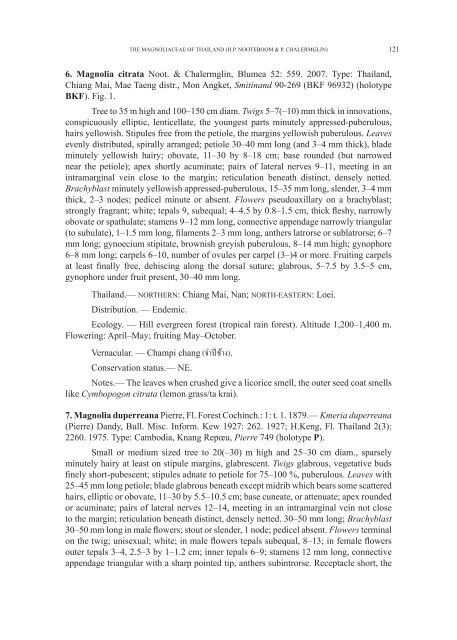You also want an ePaper? Increase the reach of your titles
YUMPU automatically turns print PDFs into web optimized ePapers that Google loves.
THE MAGNOLIACEAE OF <strong>THAI</strong>LAND (H.P. NOOTEBOOM & P. CHALERMGLIN)<br />
6. Magnolia citrata Noot. & Chalermglin, Blumea 52: 559. 2007. Type: Thailand,<br />
Chiang Mai, Mae Taeng distr., Mon Angket, Smitinand 90-269 (BKF 96932) (holotype<br />
BKF). Fig. 1.<br />
Tree to 35 m high and 100–150 cm diam. Twigs 5–7(–10) mm thick in innovations,<br />
conspicuously elliptic, lenticellate, the youngest parts minutely appressed-puberulous,<br />
hairs yellowish. Stipules free from the petiole, the margins yellowish puberulous. Leaves<br />
evenly distributed, spirally arranged; petiole 30–40 mm long (and 3–4 mm thick), blade<br />
minutely yellowish hairy; obovate, 11–30 by 8–18 cm; base rounded (but narrowed<br />
near the petiole); apex shortly acuminate; pairs of lateral nerves 9–11, meeting in an<br />
intramarginal vein close to the margin; reticulation beneath distinct, densely netted.<br />
Brachyblast minutely yellowish appressed-puberulous, 15–35 mm long, slender, 3–4 mm<br />
thick, 2–3 nodes; pedicel minute or absent. Flowers pseudoaxillary on a brachyblast;<br />
strongly fragrant; white; tepals 9, subequal; 4–4.5 by 0.8–1.5 cm, thick fleshy, narrowly<br />
obovate or spathulate; stamens 9–12 mm long, connective appendage narrowly triangular<br />
(to subulate), 1–1.5 mm long, filaments 2–3 mm long, anthers latrorse or sublatrorse; 6–7<br />
mm long; gynoecium stipitate, brownish greyish puberulous, 8–14 mm high; gynophore<br />
6–8 mm long; carpels 6–10, number of ovules per carpel (3–)4 or more. Fruiting carpels<br />
at least finally free, dehiscing along the dorsal suture; glabrous, 5–7.5 by 3.5–5 cm,<br />
gynophore under fruit present, 30–40 mm long.<br />
Thailand.— NORTHERN: Chiang Mai, Nan; NORTH-EASTERN: Loei.<br />
Distribution. — Endemic.<br />
Ecology. — Hill evergreen forest (tropical rain forest). Altitude 1,200–1,400 m.<br />
Flowering: April–May; fruiting May–October.<br />
Vernacular. — Champi chang (จำปี ช้าง).<br />
Conservation status.— NE.<br />
Notes.— The leaves when crushed give a licorice smell, the outer seed coat smells<br />
like Cymbopogon citrata (lemon grass/ta krai).<br />
7. Magnolia duperreana Pierre, Fl. Forest Cochinch.: 1: t. 1. 1879.— Kmeria duperreana<br />
(Pierre) Dandy, Bull. Misc. Inform. Kew 1927: 262. 1927; H.Keng, Fl. Thailand 2(3):<br />
2260. 1975. Type: Cambodia, Knang Repœu, Pierre 749 (holotype P).<br />
Small or medium sized tree to 20(–30) m high and 25–30 cm diam., sparsely<br />
minutely hairy at least on stipule margins, glabrescent. Twigs glabrous, vegetative buds<br />
finely short-pubescent; stipules adnate to petiole for 75–100 %, puberulous. Leaves with<br />
25–45 mm long petiole; blade glabrous beneath except midrib which bears some scattered<br />
hairs, elliptic or obovate, 11–30 by 5.5–10.5 cm; base cuneate, or attenuate; apex rounded<br />
or acuminate; pairs of lateral nerves 12–14, meeting in an intramarginal vein not close<br />
to the margin; reticulation beneath distinct, densely netted. 30–50 mm long; Brachyblast<br />
30–50 mm long in male flowers; stout or slender, 1 node; pedicel absent. Flowers terminal<br />
on the twig; unisexual; white; in male flowers tepals subequal, 8–13; in female flowers<br />
outer tepals 3–4, 2.5–3 by 1–1.2 cm; inner tepals 6–9; stamens 12 mm long, connective<br />
appendage triangular with a sharp pointed tip, anthers subintrorse. Receptacle short, the<br />
121
















